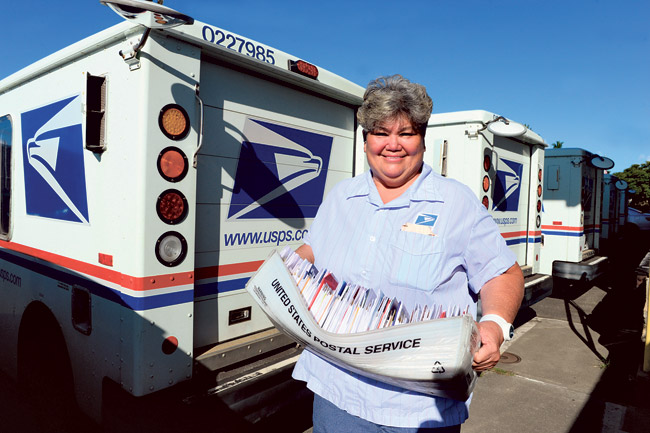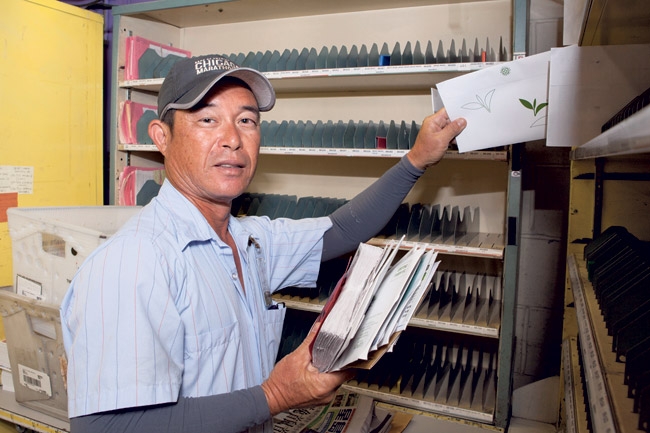Mail Carriers Carrying On For Foodbank
We all know what it feels like to be hungry. If you are fortunate enough, you probably don’t dwell on it for too long, knowing that the cure to your hunger pains is only a short trip to the refrigerator, the nearest store or restaurant. But for thousands here in Hawaii, getting enough food to eat is a daily struggle.
Saturday, the National Association of Letter Carriers (NALC) invites you to help individuals and families in Hawaii who rely on generous donations for meals with its Stamp Out Hunger Food Drive.
nm_stampouthunger_3
Last year, mail carriers on Oahu collected 337,231 pounds of food and 427,125 pounds statewide. This year, they hope to break that record with help from the community.
“Now, even more so, there are so many people in our country who are starving, are homeless and are in need of help,” says Terri Kauolu, NALC state president, who has been a mail carrier for 28 years, currently in Kailua. “It’s important to help, because we are not all on our feet – it’s important to help those who are in need.”
The effort started as a way to help New York youths who only were able to obtain regular meals through school lunches. During summer vacations, access to food and other nutritional resources were limited. Now, the Stamp Out Hunger Food Drive takes place in all 50 states, as well as the District of Columbia, Puerto Rico, the Virgin Islands and Guam.
In its 21st year, the largest single-day food drive continues to thrive.
“The amount of food that we pick up, it’s overwhelming,” says Les Omura, also a mail carrier for 28 years, currently in Pearl City, who has seen the drive evolve throughout the years.
The staggering amount of donations sometimes requires mail carriers to return to their stations to unload their trucks, adding at least an hour to their usual routes.
The number of the drive’s participants isn’t the only thing that has increased throughout the years – the quality of the food has, as well.
“Over the past 20 years, it started off as people emptying out their pantries, people getting rid of canned goods they’ve had for years,” says Omura. “Now … people go to supermarkets just to pick up cases of Vienna sausage and Spam. The sophistication has grown a lot.”
At this point, most residents throughout the state already have received blue bags in the mail, which are to be used for canned goods and other non-perishable donations. Families with children may have seen a flier come home from school detailing information about the drive.
Don’t let the limitations of the bag dissuade you from giving more. Sometimes, the biggest donations come from the smallest contributors.
Kauolu witnessed this one year on her route while picking up donations at a condominium, when a mother rushed down to make sure she didn’t miss the truck – all because of her son. He had received a flier about the drive at school and urged her to make a donation.
“It’s awesome that the kids remember that, and to get the food out,” says Kauolu. “It impresses me … the children in schools who are willing to help at that young age.”
Kauolu recommends placing donations in your mailbox. If you feel drawn to make a larger donation that won’t fit in your mailbox, just remember to let your mail carrier know by leaving a note explaining where to find it.
Beginning at 3 p.m. Saturday, trucks on lend from various companies will collect donations from participating post offices to be delivered to Hawaii Foodbank. Volunteers from an array of local organizations, including postal workers, then spend the rest of the evening sorting the donations.
Hawaii Foodbank, a certified member of Feeding America, then distributes the food to organizations (about 250) locally and on Kaua’i. Collections from other islands go to Maui Foodbank and Food Basket on Hawaii Island, both of which work with Hawaii Foodbank as partner distribution organizations.
Annually, Hawaii Foodbank feeds 183,500 people and distributes an average of 1 million pounds of food each month, according to a fact book printed in 2012.
“Why we get involved (Hawaii Foodbank) is that the more we can help them out and promote (the drive) … the more food we’re going to be getting,” says Mike Kajiwara, Hawaii Foodbank director of product donations.
Among the most important items Hawaii Foodbank needs is canned meats. Other canned items include meals, soups, beans, fruits and vegetables.
For more information about the food drive, contact NALC coordinator Adele Yoshikawa at 351-4095.







